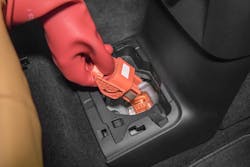If your shop hasn’t already performed a repair on an Electric Vehicle (EV), the likelihood of that changing soon has never been stronger, with approximately 115 new EV models expected to hit the road over the next 30 months.
In fact, scores of shops are already in the throes of this “electrifying shift,” converting space and training technical staff to take advantage of this exciting era of collision repair.
To fully prepare for this transformative time, I cannot overemphasize the critical importance of key safety considerations that must be in place before any such repair can be performed on these high-voltage vehicles. And this begins with some safety basics, including Personal Protective Equipment (PPE).
Members of I-CAR’s Technical Team recently created a series of videos that dive into some of the safety considerations, the first of which is PPE. The following is a high-level view, with a link to the full video here: https://info.i-car.com/onlinemagazine/CollisionReporter_Electrification_FINAL/#page=18
Unplug the charging port
While it may sound like common sense, it’s very important to understand that anytime you work on an EV to completely unplug from the charging port. When the charger cable is connected, the high voltage contacts will be closed, and this is dangerous to anyone working on the vehicle. I can appreciate the desire to have a fully charged battery – that is good for the customer. But when we're working on an EV, we're working on a high voltage system. The first rule is to unplug this cable! Have that basic consideration memorized as this is easily forgotten.
Lock away the key
Again, this may sound like a no-brainer, but I suggest physically moving an EV vehicle’s key/key fob to an external area – even a lock box - to avoid the possibility of triggering a “live,” high-voltage system.
Pre-scan verification
Pre-scanning the EV will allow you to verify the absence of any faults in the vehicle and gain confidence in the overall electrical integrity of the high-voltage system.
High-voltage safety gear
Look, I recognize that PPE can feel cumbersome when you’re wearing it, but it truly is your best defense. Additionally, some may outfit themselves with PPE but not wear this critical safety gear the correct way. Please wear the PPE, and wear it properly – it can save your life!
To that end, welding gloves are not appropriate PPE! Nitrile gloves – those green, black and blue ones – are NOT high voltage safety gloves. They're great for working with chemicals and other things, but you do not want to trust your life to those when working on a high-voltage system.
Instead, you need “Class 0” gloves, sometimes referred to as lineman gloves – these are the gloves you need whenever you are working with an active EV. In the event of a high-voltage exposure risk, they provide additional safety redundancy for you. In the event of some unknown fault or compromise – it’s your last line of defense.
Leather protectors are to be worn over top of lineman’s gloves and should not be used for any other type of work so they don’t end up picking up any contaminants, such as metal splinters. They are there to protect the lineman’s gloves from getting punctured or damaged whenever you're doing work.
Keep those gloves on when you pull the battery service disconnect. This is often the time where the temptation to take the gloves off becomes real, but please fight through those thoughts and leave the gloves on.
Two-pole voltmeter check
The safety stakes are that much higher when you are unsure of the state of the battery, such as, is there an open lead from an orange cable to the chassis? It's critical that everyone understands the importance of disabling these vehicles and confirming they are safe before they start working on the vehicle.
Before I touch a vehicle, I personally use my two-pole voltmeter to check for any potential connection to the chassis. This step may not be as well known, but I feel we have a responsibility to educate the whole industry – not only the collision repairer, but those individuals who bring vehicles into the shop, drive tow trucks, etc.
Be advised that a regular shop multimeter should not be used; too many errors can happen, including setting an incorrect measurement group. Finally, a milliohm meter should be used to measure the component bonding -- along with an insulation tester -- to help ensure a safe environment.
OEM repair procedures – before pulling service disconnect
Please ensure you have the OEM procedures available before you start pulling the service disconnect – do not just read them beforehand, but actually have them with you at the vehicle. That way, if you're having difficulty getting that disconnect out, you can look at the procedures and understand all the interlocks and disengagement steps needed before you attempt to get that disconnect out.
No place for complacency
There is a tendency to view an EV repair like “any other.” There is absolutely no substitute for pulling OEM repair procedures. I would certainly encourage any shop exploring EV work to follow OEM recommendations for certifications and training around those specific vehicles. I also encourage you to consider some of the I-CAR training on EVs. In fact, our new “Charged for EV” resource is a free online tool for the latest EV news, training, podcasts and more. https://info.i-car.com/electric-vehicles



